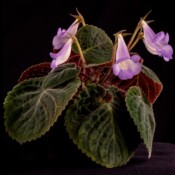Exhibited in the 2021 virtual show of the Gesneriad Society.
Advanced Search

Sinningia ‘Sher’s Pink Sparkler’
Exhibited in the 2021 virtual show of the Gesneriad Society.
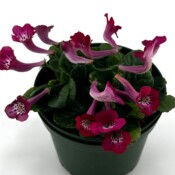
Sinningia ‘SimSim Salaviem’
Exhibited at the 2025 spring show of the Toronto African Violet and Gesneriad Society. Sinningia ‘SimSim Selaviem’ is often touted as the first “true red” micro miniature Sinningia. Its beautiful color is set off by the white spotted throat. Another
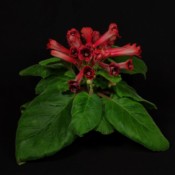
Sinningia ‘Spellbound’
Exhibited at the 2012 convention of the Gesneriad Society. This fine cultivar created by Peter Shalit can be grown in at least a couple of ways. In the case of the featured photo above, the plant has been grown as a single crown, with a fine
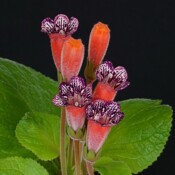
Sinningia ‘Tomorrow’
The product of several generations of focused hybridization, S. ‘Tomorrow’ exhibits the upright peloric-flowered form characteristic of modern hybrids of Sinningia speciosa, albeit with much smaller flowers. Peloric flowered forms of S. cardinalis are ancestral to this breakthrough cultivar.
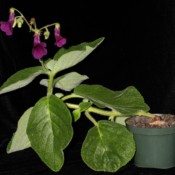
Sinningia bragae
Exhibited at the 2017 convention of the Gesneriad Society. This plant was known as Sinningia sp. “Ibitioca” (from its collection location) for many years, until it was officially published. It is closely related to Sinningia aghensis, with which it
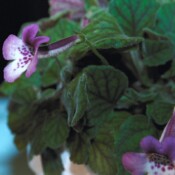
Sinningia concinna
Sinningia concinna is one of the “micro” species of Sinningia. A plant may have one or more crowns, but each crown is usually less that 5 cm [2 inches] in diameter. The species is prized for its beautifully spotted flowers and nicely
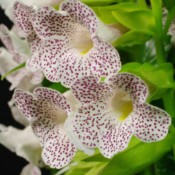
Sinningia guttata
Sinningia guttata has been known to botany and horticulture since the early 19th Century (see our botanical prints), but was long out of cultivation until relatively recently. It has proven to be a very worthwhile addition, with beautiful spotted flowers, a
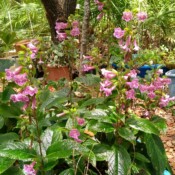
Sinningia guttata x ( S. ‘Apricot Bouquet’ x S. sellovii)
Exhibited in the 2021 virtual show of the Gesneriad Society. This interesting and vigorous hybrid was grown outside in the ground, near Gainesville, Florida, USA. It reblooms throughout the growing season, except when it freezes. The foliage dies back with frosts or freezing temps, but grows
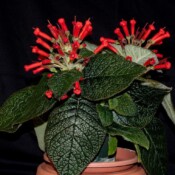
Sinningia hybrid (‘Esther’ x bullata)
Exhibited at the 2021 virtual show of the Gesneriad Society.
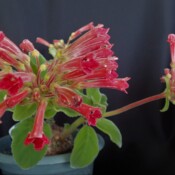
Sinningia hybrid (S. piresiana x ( S. piresiana x S. cardinalis))
Exhibited at the 2021 virtual show of the Gesneriad Society.
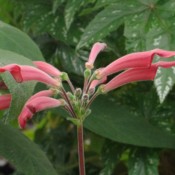
Sinningia iarae
S. iarae is a species that has been introduced to cultivation relatively recently, in large part because of the efforts of Mauro Peixoto of São Paulo, Brazil. The flower has the overhanging upper lip (“galea”) characteristic of related species, such as S.

Sinningia leucotricha
Sinningia leucotricha has had a confusing recent taxonomic history. Material in cultivation was known under this name for some time, before it was understood to be properly a different species, S. canescens. After some years under this name, the “true” S.

Sinningia macrophylla
This interesting species has large leaves and beautiful purple/lavender flowers similar to those of its close relative S. speciosa. The emerging leaves have a red margin and sometimes a reddish central vein. Buds have red hairs covering them. The overall effect is dramatic.

Sinningia macropoda
This impressive species can grow to a large size, with large leaves, many flowers and an enormous partly-exposed tuber. It can also be managed as a more modest and tidier plant, to good effect. Additional photos can be seen in a slideshow by clicking one of
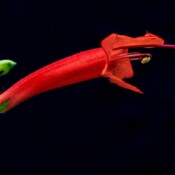
Sinningia sp. “Coromandel”
This is a newly discovered and as-yet unpublished species. It was found in Minas Gerais state, in Brazil. It grows on moist rocks in shady places. Photos of the species growing “in the wild” can be seen here. Note in that picture the
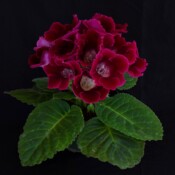
Sinningia speciosa ‘Empress Mix’
Sinningia speciosa ‘Empress Mix’ is a high quality seed-line produced in Japan and available commercially as pelleted seed. It is a blend of various colors with a similar over-all appearance and size. Seed will bloom within three months from sowing, although the most spectacular

Sinningia speciosa ‘NG Chinzano’
Exhibited in the 2021 virtual show of the Gesneriad Society.

Sinningia speciosa ‘Regina’
Sinningia speciosa ‘Regina’ has become a catch-all category for plants within the S. speciosa group that have patterned leaves, dark with silvery vein markings. Within the category are a wide variety of plants with differently colored flowers, plant sizes, leaf shapes, etc.
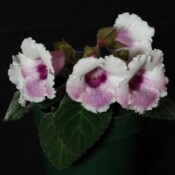
Sinningia speciosa ‘Rock Loves Paul’
Exhibited at the Gesneriad Society’s 2021 virtual show. This wonderful modern hybrid is a cross between a “standard” S. speciosa hybrid and, according to the hybridizer Jay Sespico, a complex hybrid involving S. guttata, S. ‘Ozark
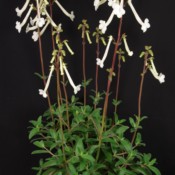
Sinningia tubiflora
This spectacular specimen was exhibited at the 2016 convention of the Gesneriad Society. For scale, the pot is probably at least 8″ in diameter. The beautiful flowers are born on a very long flowering stem. The flowers are very fragrant, as well as beautifully shaped and
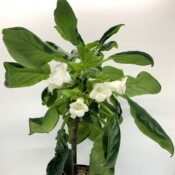
Sinningia velutina
Sinningia velutina is closely allied to S. guttata, and has historically been confused with both that species and S. helleri. Dr. Alain Chautems, of the Geneva Botanical Garden, notes that S. velutina

Sinningia warmingii
The plant featured above was exhibited in the 2021 virtual show of the Gesneriad Society. It was grown outside, in Kentucky, USA (climate zone 6b-8), left in the ground uncovered all winter. Other view of this species can be seen in a slideshow by clicking one

Smithiantha ‘Little One’
S. ‘Little One’ was a seedline sold by Parks Seed Company for many years, sometimes referred to as S. ‘Park’s Little One’. It has been widely grown for the velvety red and green leaves, and the very attractive bright orange and
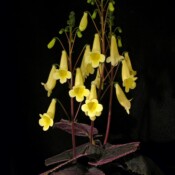
Smithiantha ‘Stone’s Lemon Tea’
Exhibited at the 2021 virtual show of the Gesneriad Society.
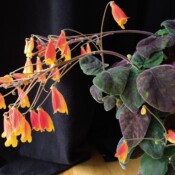
Smithiantha zebrina
Smithiantha zebrina is an ancestor of many, if not most, of the modern Smithiantha hybrids. It’s plush red foliage has long been favored by growers, and the often-spectacular orange and yellow flowers provide a very nice contrast. The plant featured above was
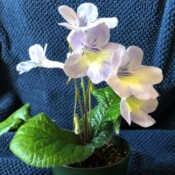
Streptocarpus ‘Bristol’s Solar Wind’
Exhibited at the 2021 virtual show of the Gesneriad Society.
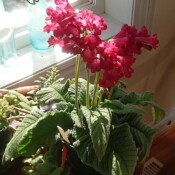
Streptocarpus ‘Dale’s Gingersnaps’
Streptocarpus ‘Dale’s Gingersnaps’ is an interesting hybrid. Its pollen parent is the species S. dunnii, which is the source of all red color in Streptocarpus. Normally, S. dunnii is a unifoliate plant — it only ever
« Previous 1 2 3 4 5 Next »


